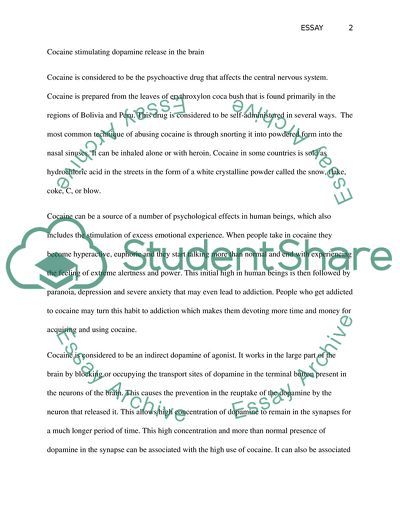Cite this document
(The Mechanisms That Stimulate Dopamine Release in the Brain Essay Example | Topics and Well Written Essays - 1250 words, n.d.)
The Mechanisms That Stimulate Dopamine Release in the Brain Essay Example | Topics and Well Written Essays - 1250 words. https://studentshare.org/psychology/1821180-compare-and-contrast-the-mechanisms-employed-by-cocaine-ecstasy-heroin-and-cannabis-to-stimulate-dopamine-release-in-the-brain-and-how-this-relates-to-their-abuse-potential
The Mechanisms That Stimulate Dopamine Release in the Brain Essay Example | Topics and Well Written Essays - 1250 words. https://studentshare.org/psychology/1821180-compare-and-contrast-the-mechanisms-employed-by-cocaine-ecstasy-heroin-and-cannabis-to-stimulate-dopamine-release-in-the-brain-and-how-this-relates-to-their-abuse-potential
(The Mechanisms That Stimulate Dopamine Release in the Brain Essay Example | Topics and Well Written Essays - 1250 Words)
The Mechanisms That Stimulate Dopamine Release in the Brain Essay Example | Topics and Well Written Essays - 1250 Words. https://studentshare.org/psychology/1821180-compare-and-contrast-the-mechanisms-employed-by-cocaine-ecstasy-heroin-and-cannabis-to-stimulate-dopamine-release-in-the-brain-and-how-this-relates-to-their-abuse-potential.
The Mechanisms That Stimulate Dopamine Release in the Brain Essay Example | Topics and Well Written Essays - 1250 Words. https://studentshare.org/psychology/1821180-compare-and-contrast-the-mechanisms-employed-by-cocaine-ecstasy-heroin-and-cannabis-to-stimulate-dopamine-release-in-the-brain-and-how-this-relates-to-their-abuse-potential.
“The Mechanisms That Stimulate Dopamine Release in the Brain Essay Example | Topics and Well Written Essays - 1250 Words”. https://studentshare.org/psychology/1821180-compare-and-contrast-the-mechanisms-employed-by-cocaine-ecstasy-heroin-and-cannabis-to-stimulate-dopamine-release-in-the-brain-and-how-this-relates-to-their-abuse-potential.


